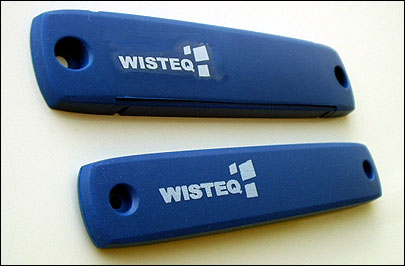Wisteq, a Finnish company specializing in reusable RFID tags, says it has designed a new type of UHF antenna capable of performing especially well when the tag is attached to metal or objects containing liquids—environments known to cause problems for RFID due to their respective RF-reflecting and -absorbing properties.
“Problems with RFID tags around water or metal are not the fault of HF or UHF, but the design of the antenna,” says Olavi Meriläinen, CEO of Wisteq. “Almost every tag on the market is based on a dipole design, but it can’t work around metal and liquids.”

This, Meriläinen explains, is primarily because dipole antennas radiate their signals equally in all directions. The RF signals of tags attached to metal or containers of liquid are wasted by being directed toward those problematic materials. The solution, according to Wisteq, is a microstrip antenna that creates a very different RF reflection pattern, configured to focus signals in a single direction. This, the company says, keeps the signals from getting absorbed in water or reflected by metal and becoming lost to the reader.
Consisting of a narrow metallic conductor bonded to a thin dielectric substrate backed by a conductive ground plate, microstrip antennas have primarily been used in aerospace and mobile applications. Although relatively economical to manufacture, such antennas have remained too expensive for producing passive RFID tags. Wisteq says it has spent two years developing a microstrip antenna for passive RFID tags that can be manufactured cheaply enough to be viable for reusable tags.
According to Wisteq, its new microstrip antenna is joined to an RFID chip by the same methods and materials used to affix a dipole antenna to an RFID chip, thereby lowering the manufacturing cost. The antenna will be incorporated in a new reusable tag encased in a protective plastic housing.
Although this microstrip antenna is designed to improve the performance of its tags on metal and around liquids, the company says it still needs to refine the design before its first tags are commercially available, which it anticipates will be at the end of this summer. “We have read range of around 4 meters [13.1 feet] when the tag is fastened to metal, but are increasing that by fine-tuning the antenna,” says Meriläinen. “In free air [attached to wood or some other RF-transparent object], the same tag can be read from 5 meters [16.4 feet]. So properties of this design are not totally independent from the carrier to which it is fastened, but the influence is minimal compared with other existing tag types.” In October, the company launched a reusable UHF tag model, the WTUG, made with a dipole antenna (see Finnish Co. Makes Reusable Gen 2 Tags). The WTUG model offers a read range of 2.5 meters (8 feet) when attached to metal or a container of liquid, or 4 meters in free air.
However, the microstrip-antenna tag will retain certain drawbacks. Since the design will support only a narrow frequency band, the tag will be able to function using either the U.S. or European UHF spectrum—but not both. Wisteq says it is developing a European version of the tag first, with plans to make a U.S. version at a later date. In addition, manufacturing costs for microstrip antennas will remain higher than those of dipole alternatives. Wisteq says it will sell the new tags for €5 ($6.42) each in quantities of 100,000 units, doubling the price of its existing equivalent dipole-based tags.
“When used in an RFID tag, the cost per microstrip antenna is still higher than that of a traditional dipole antenna, but that is the necessary price for the improvement in performance,” says Meriläinen.
Founded in January 2004, Wisteq initially made tags based on the ISO 18000-6 B standard or the Tagidu-Palomar protocol. Herein, the company says all of its products will be based on the Gen 2 EPC RFID standard.

